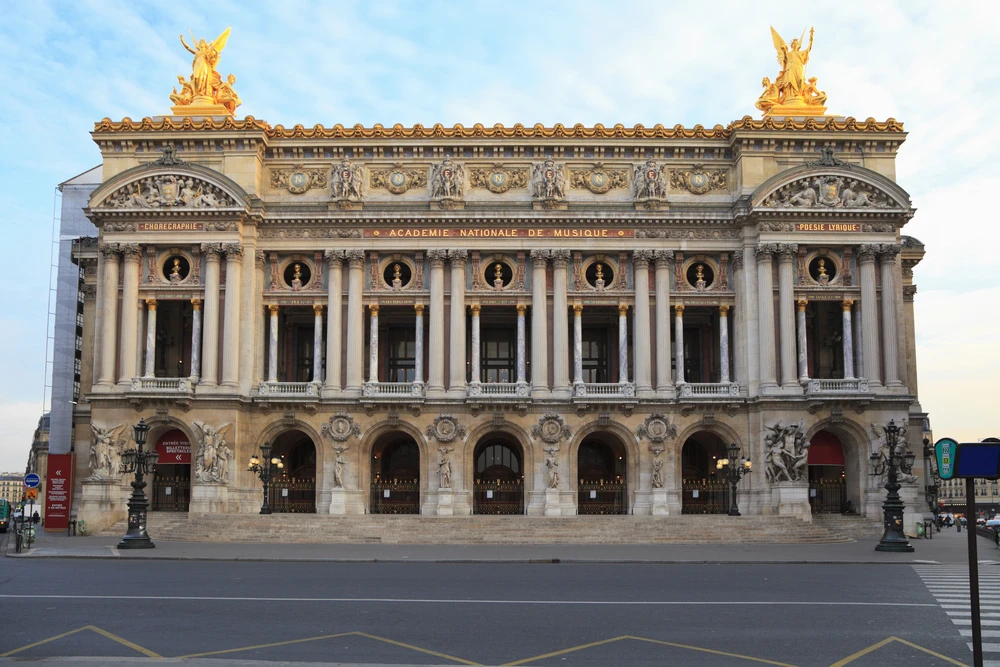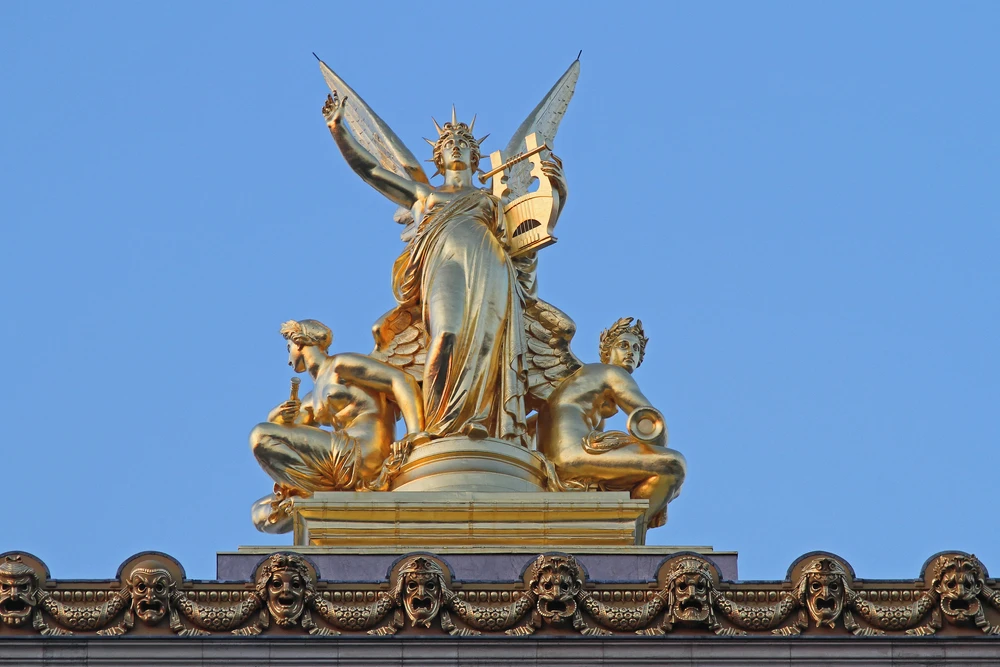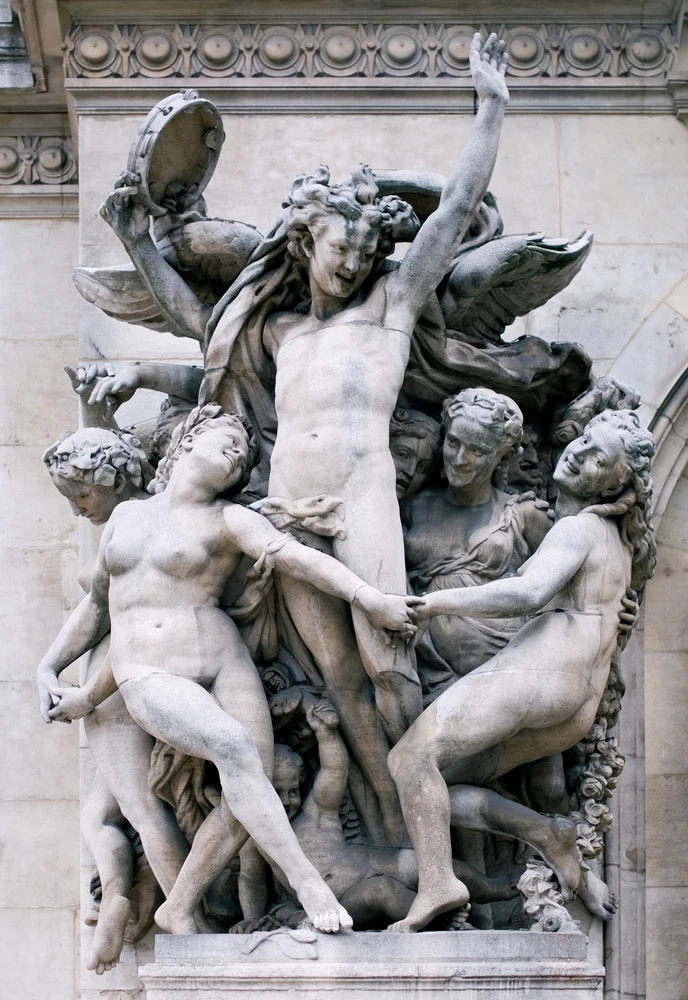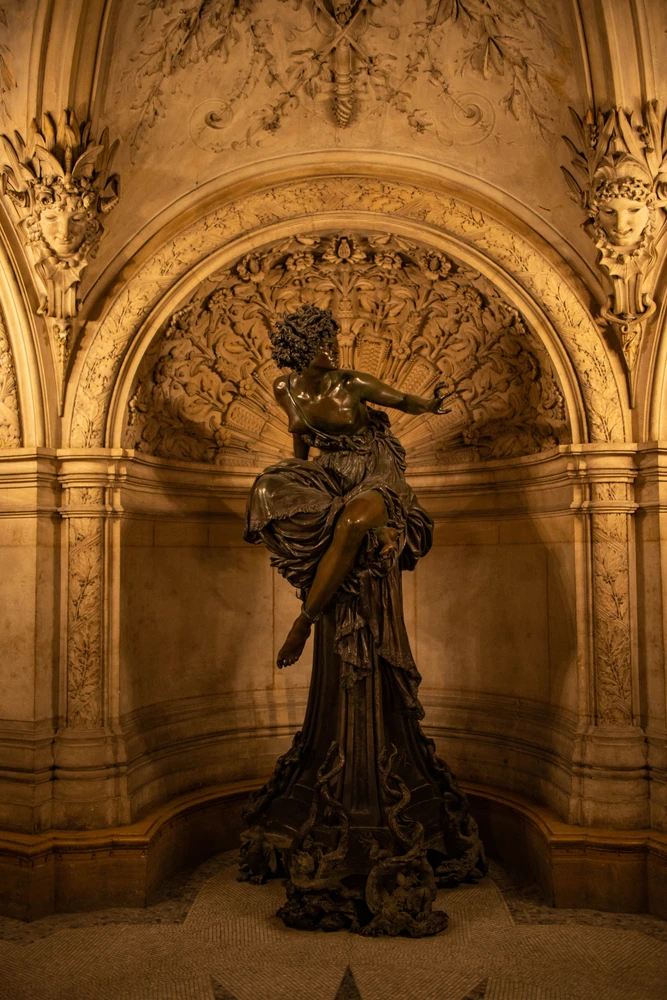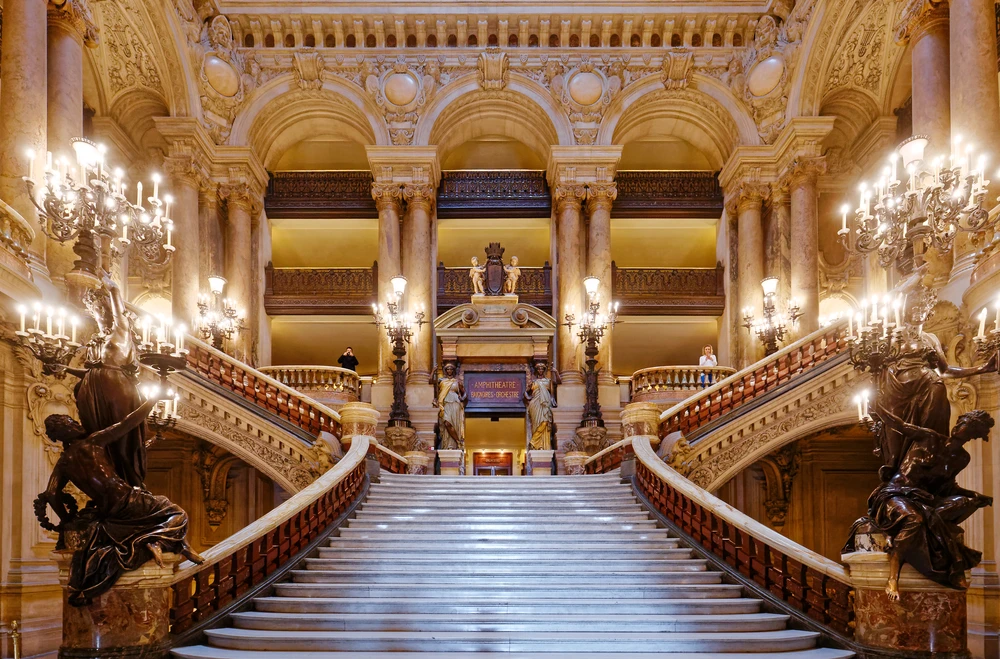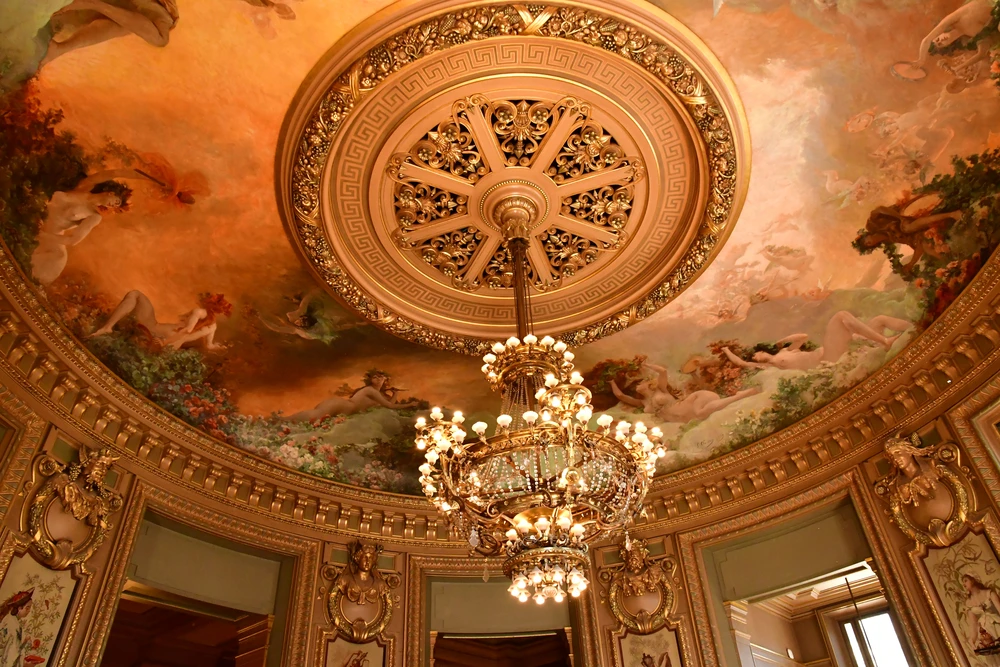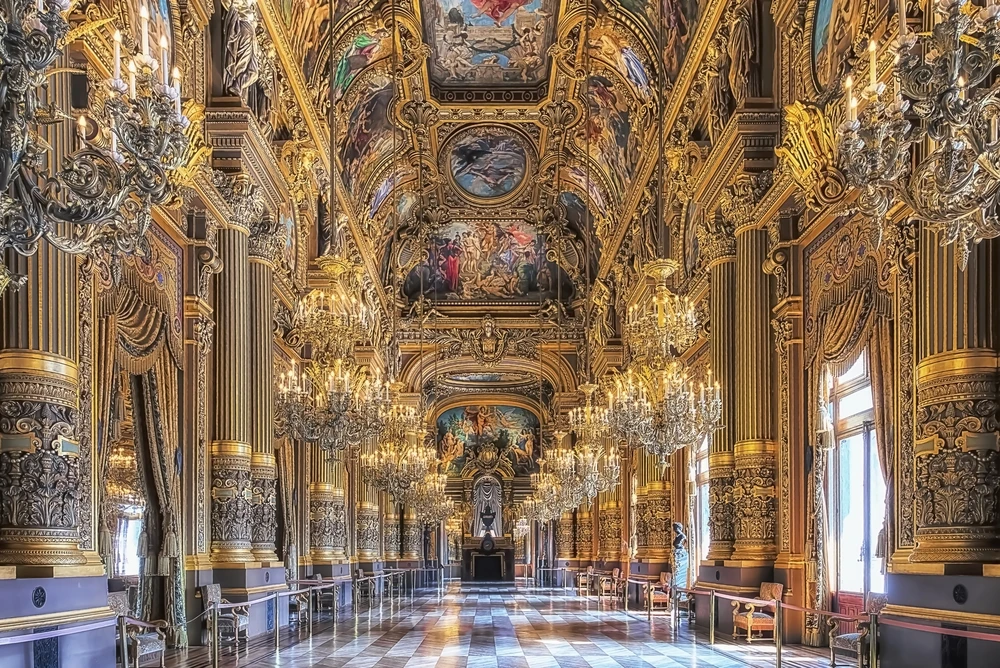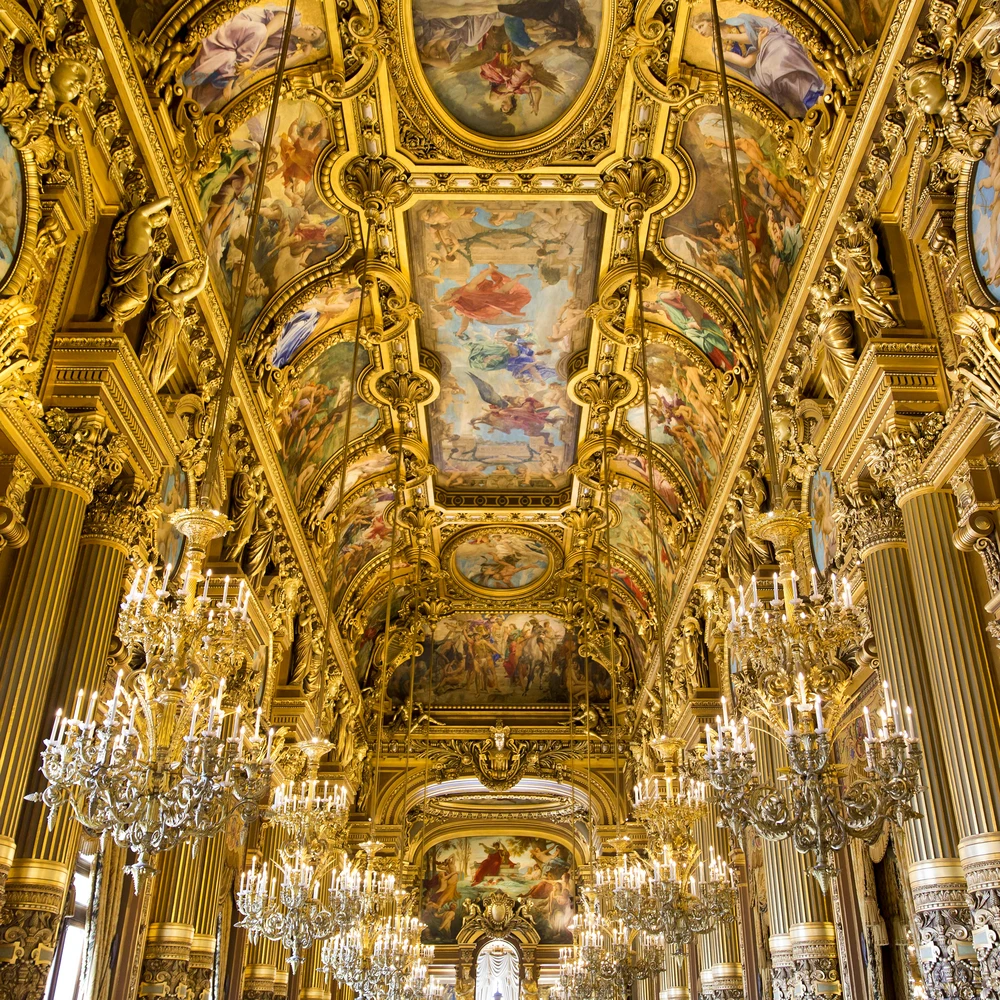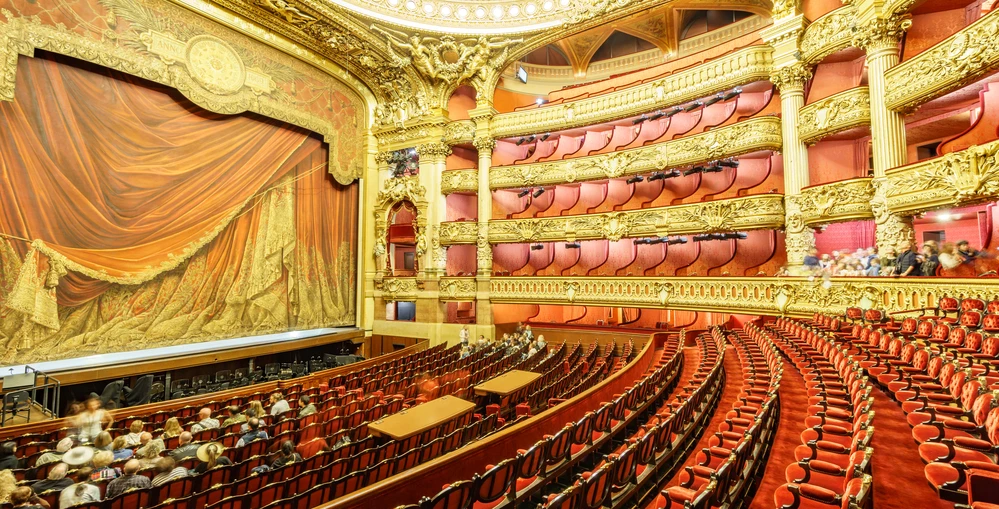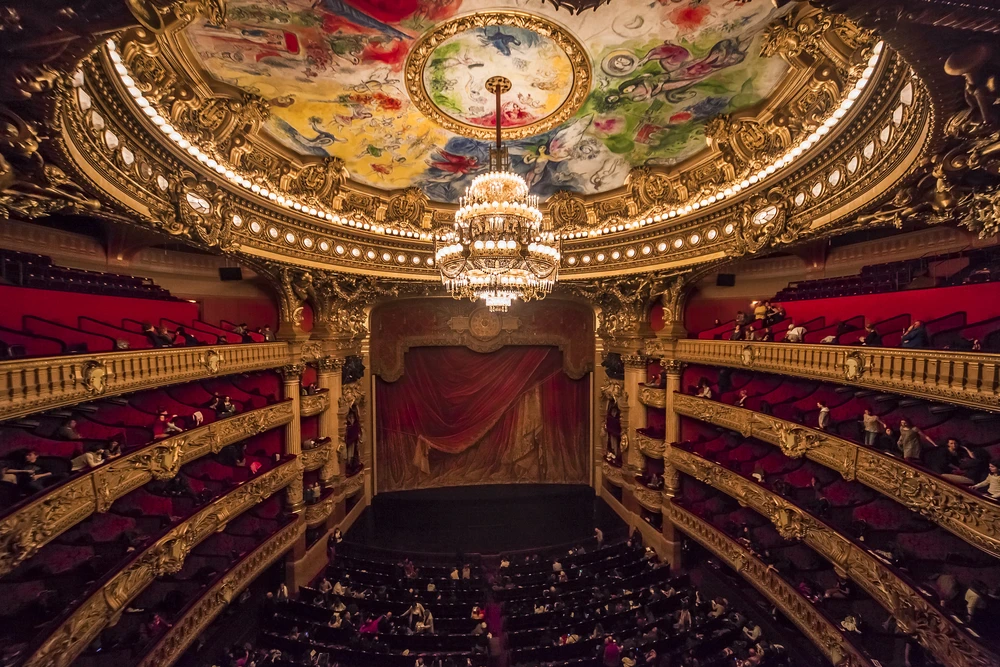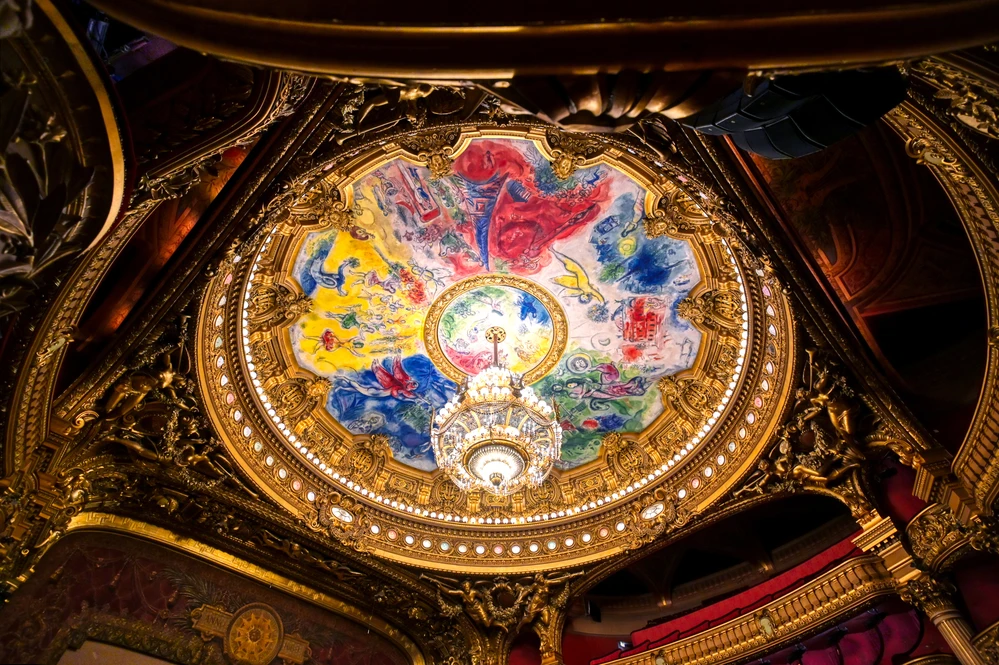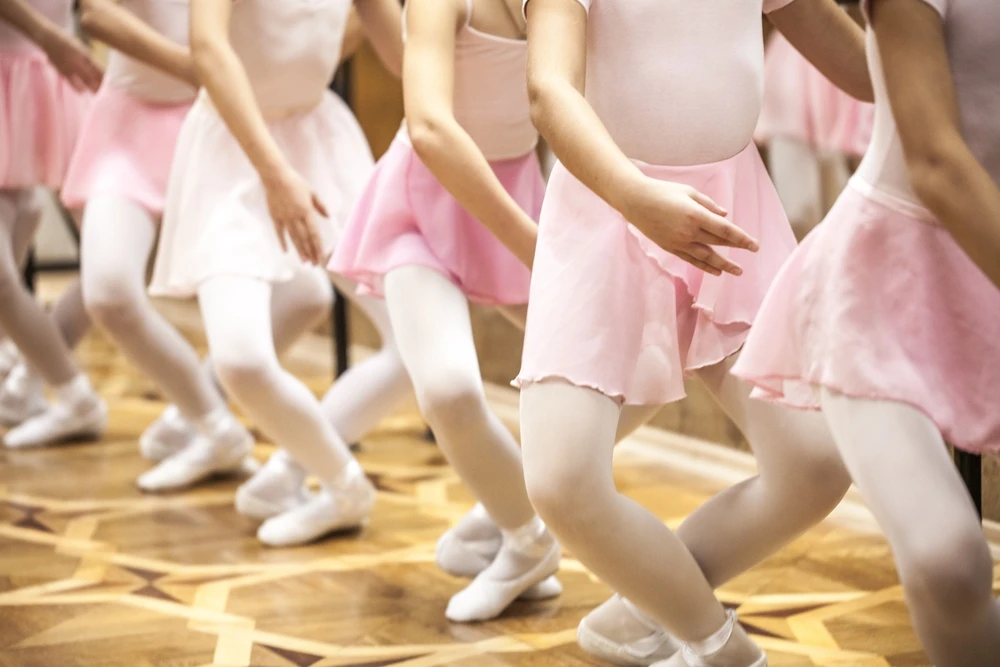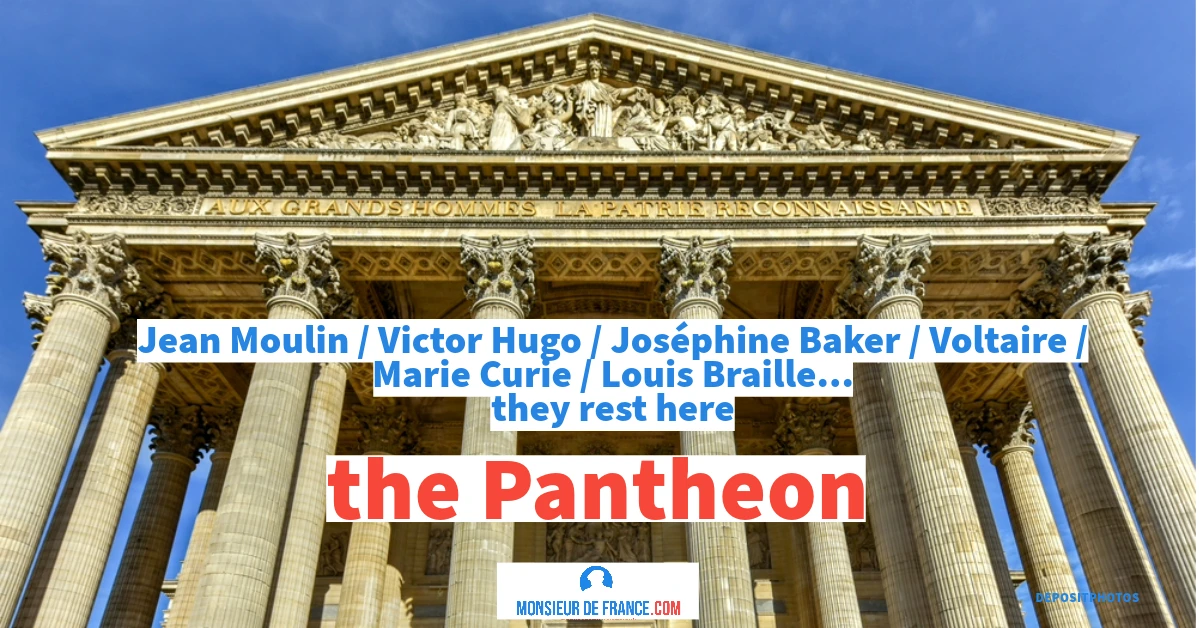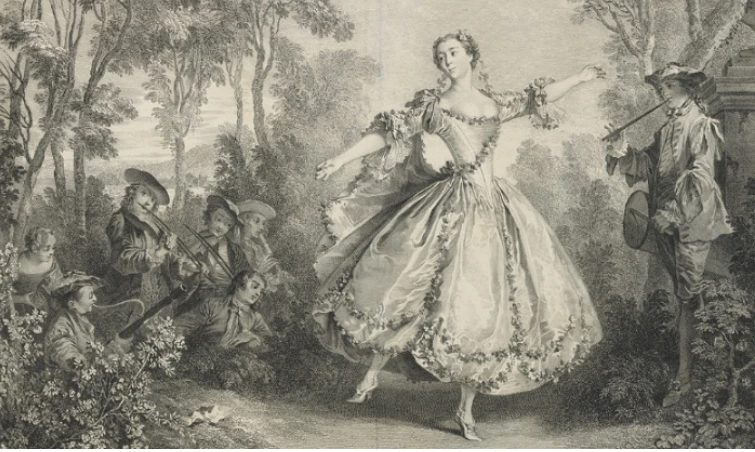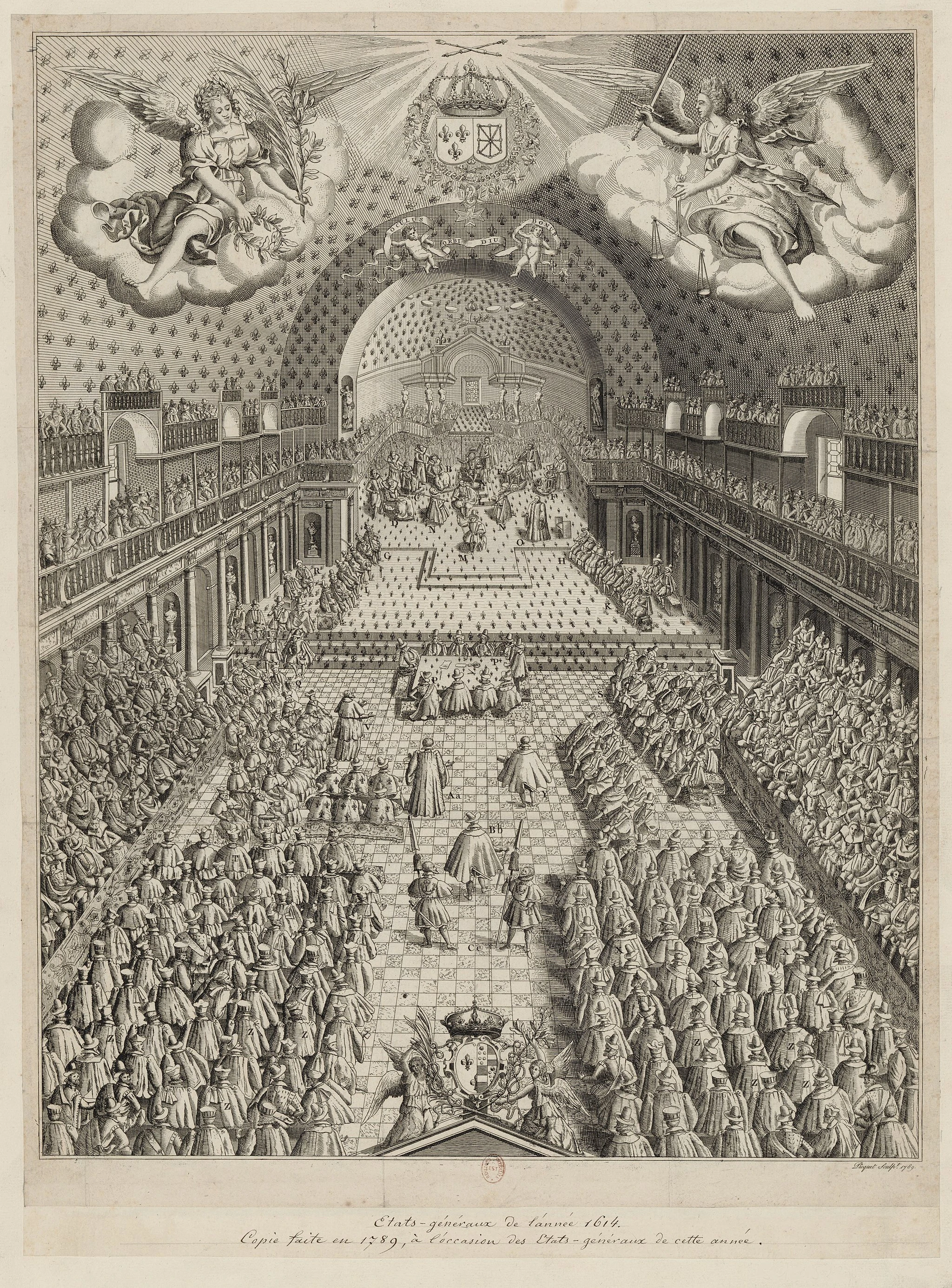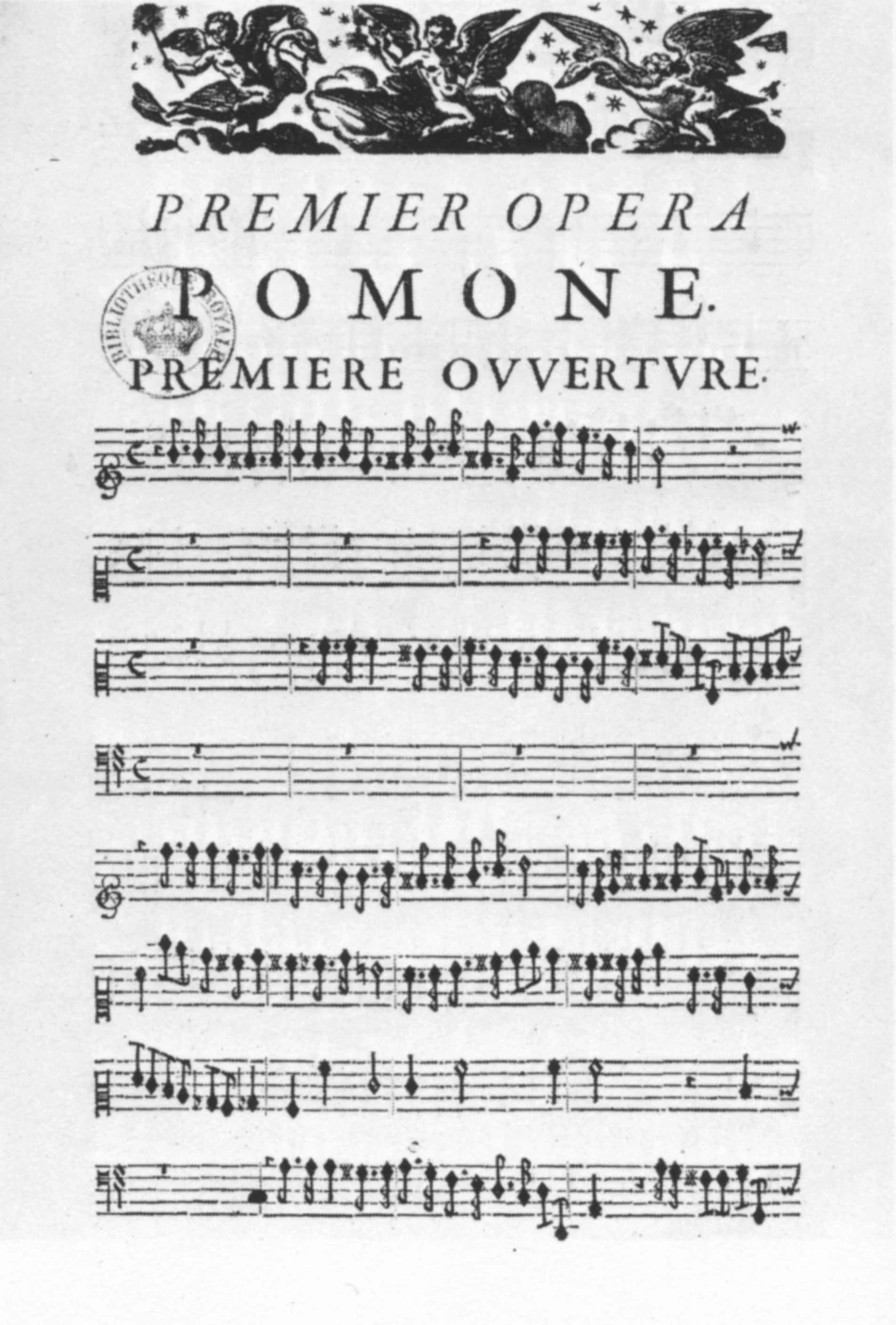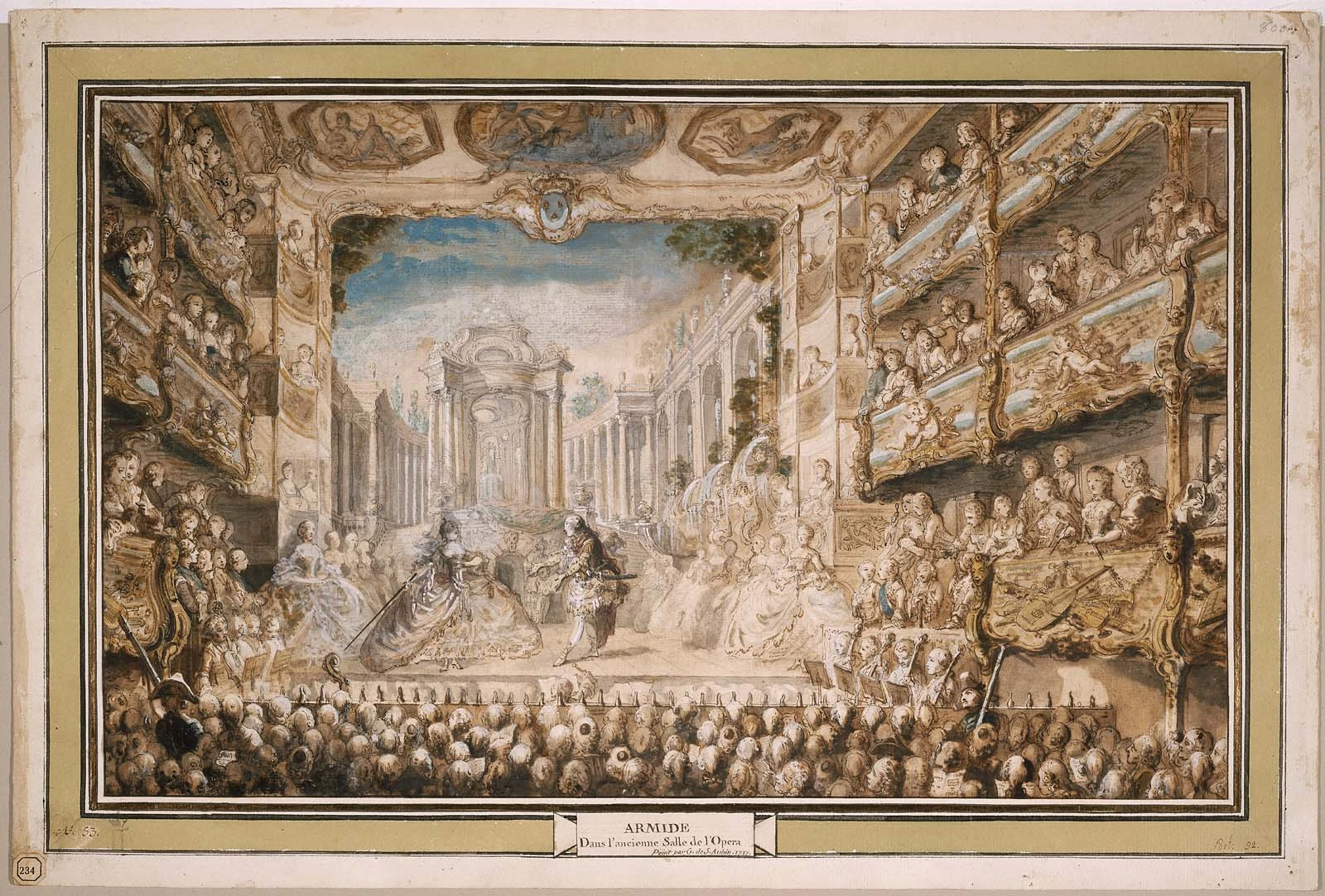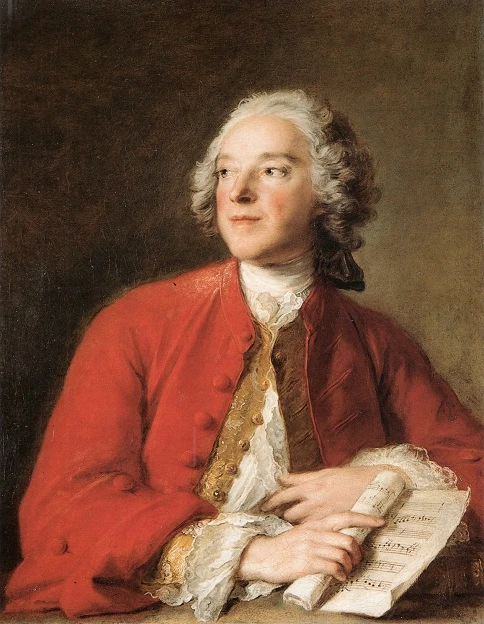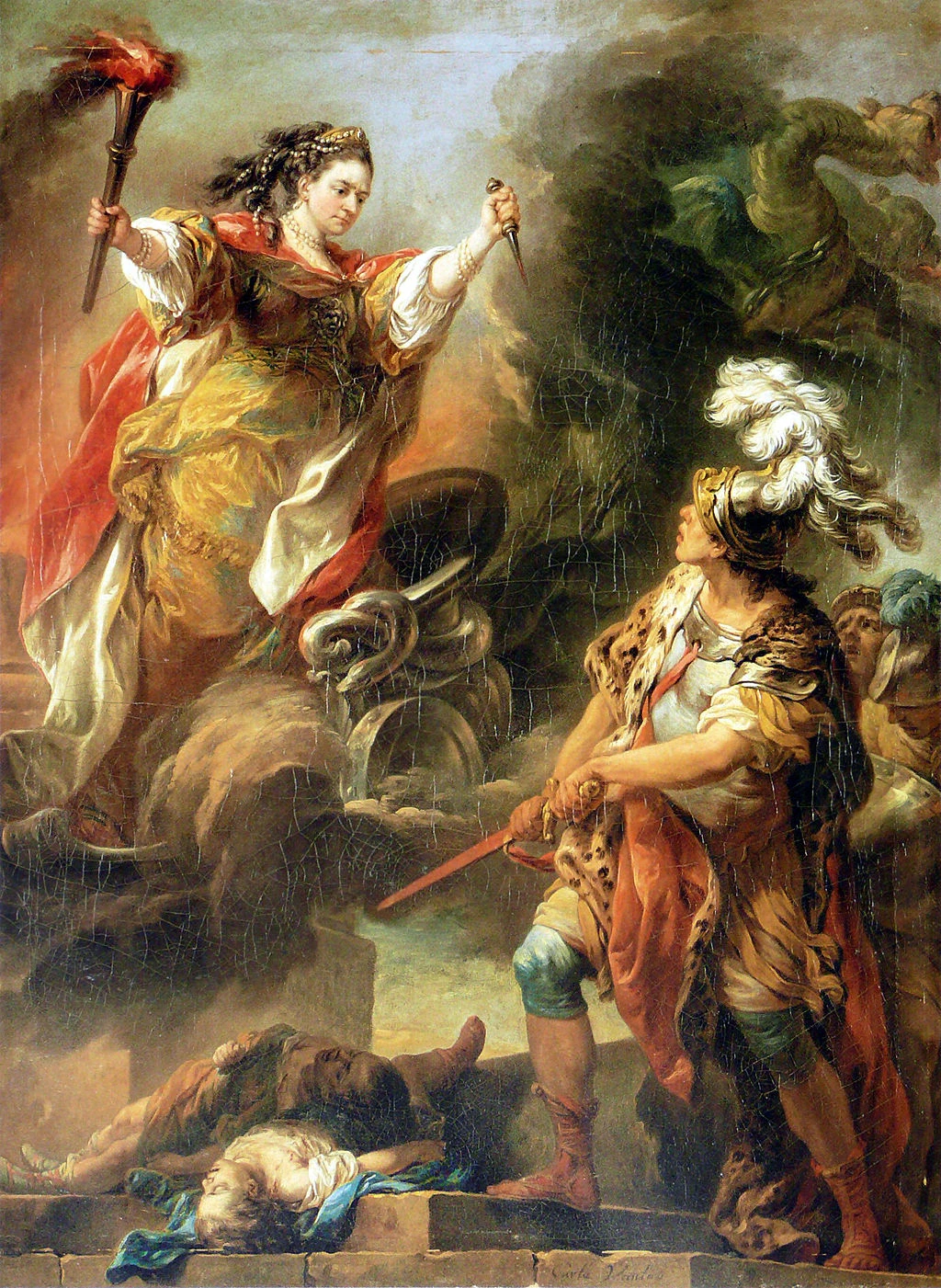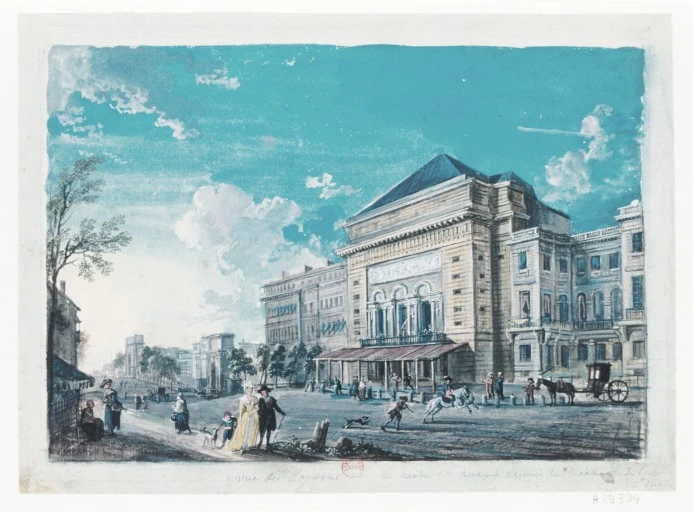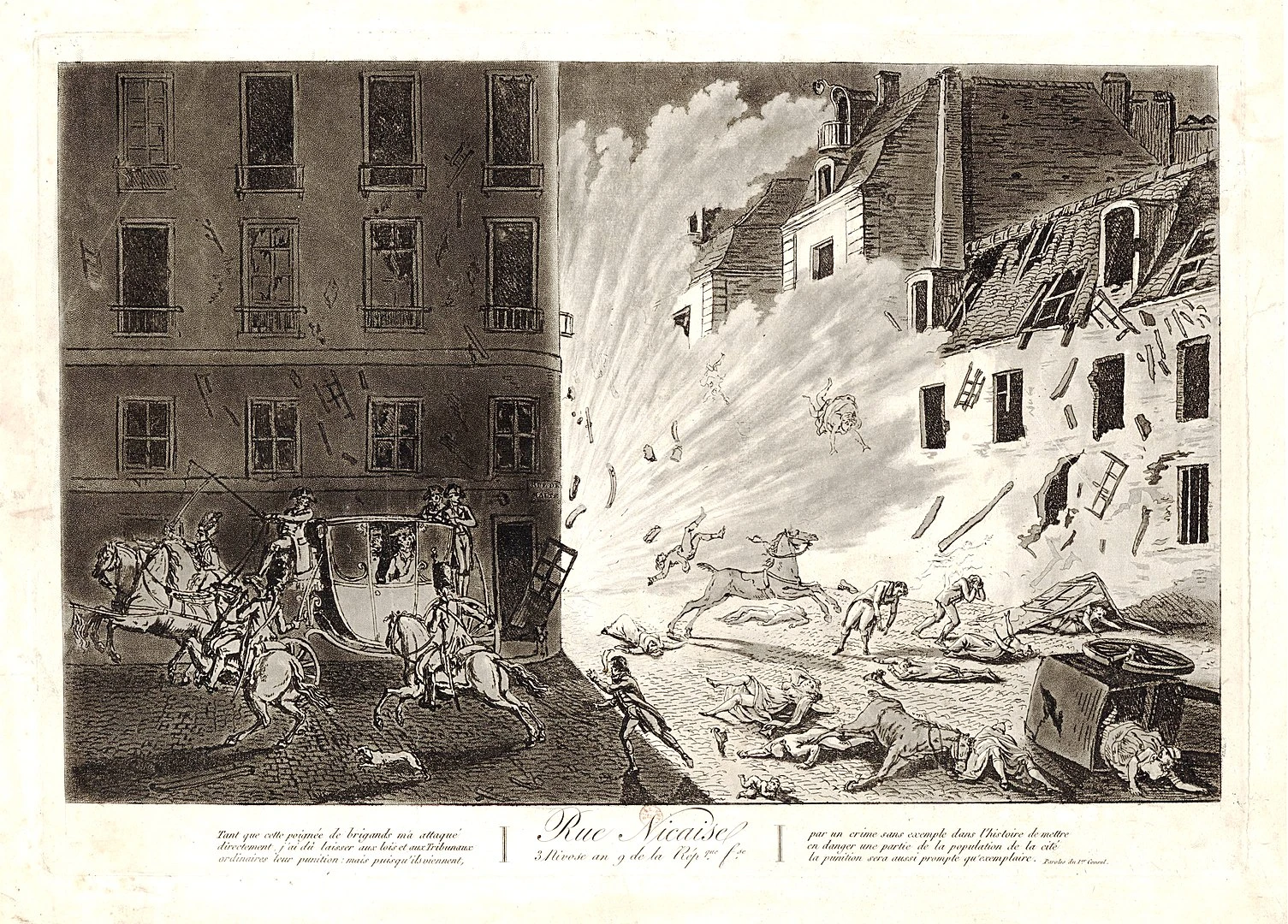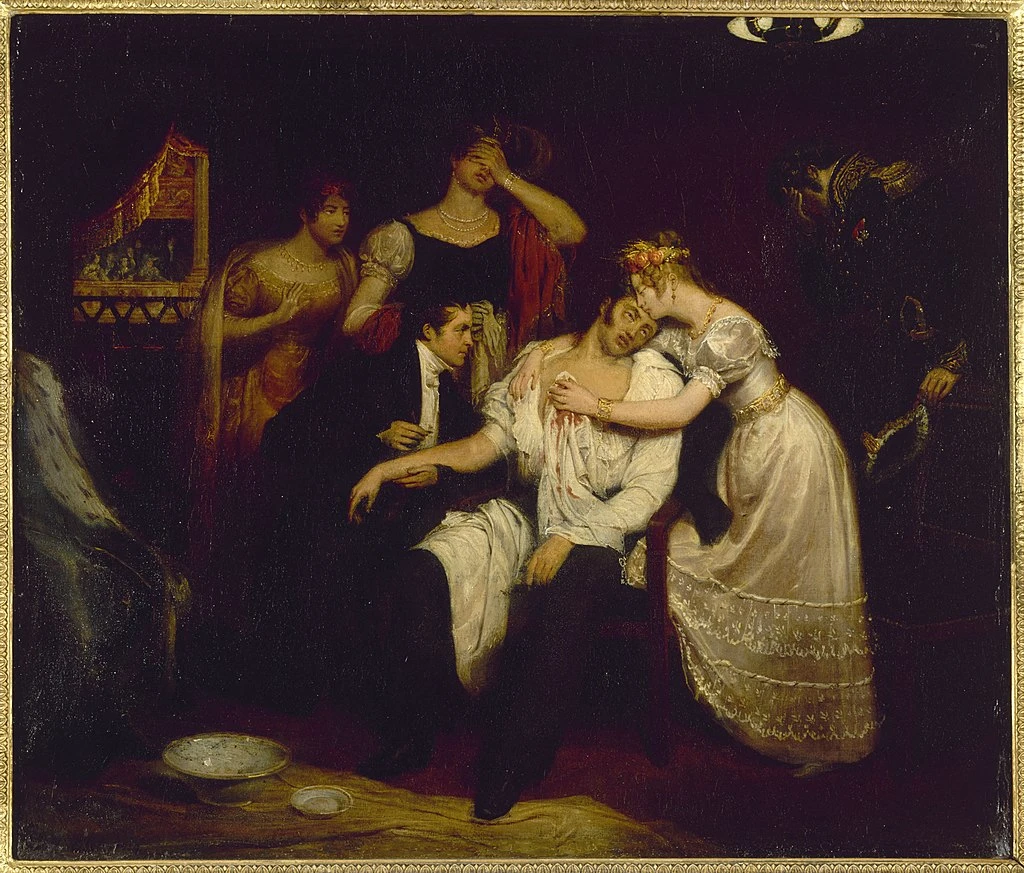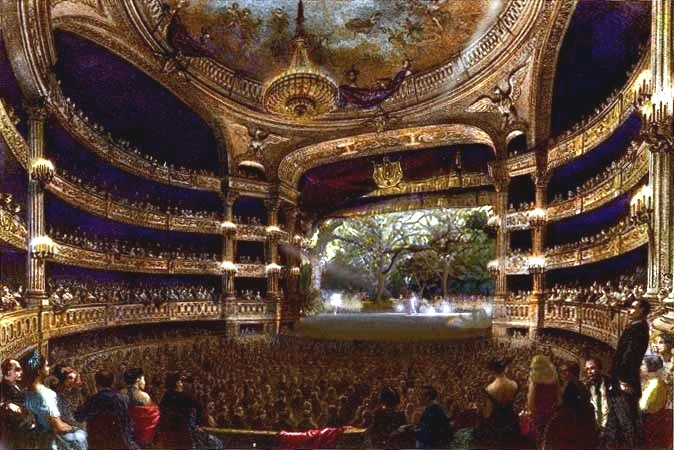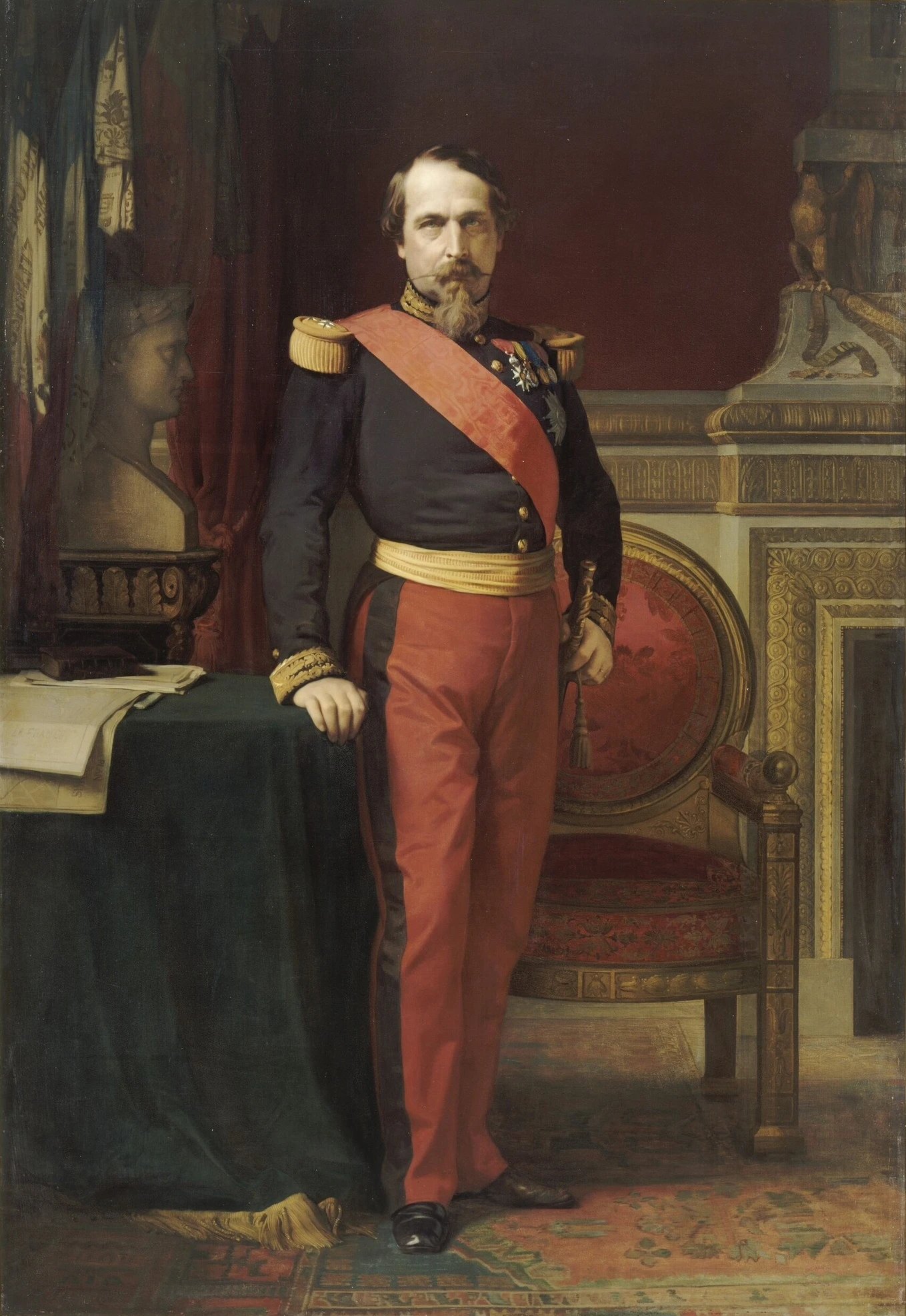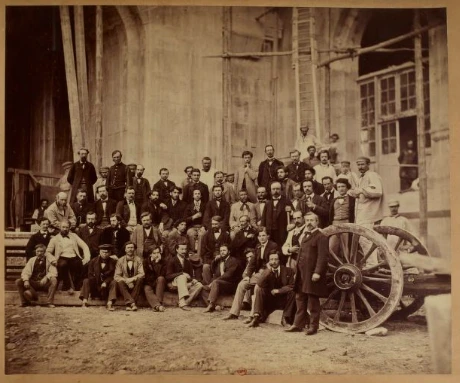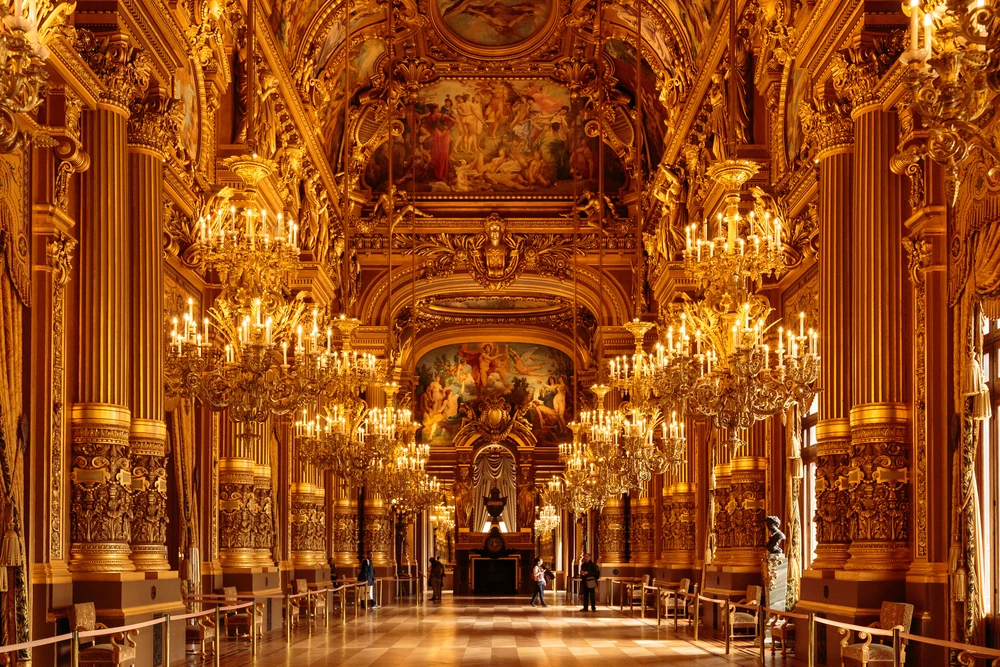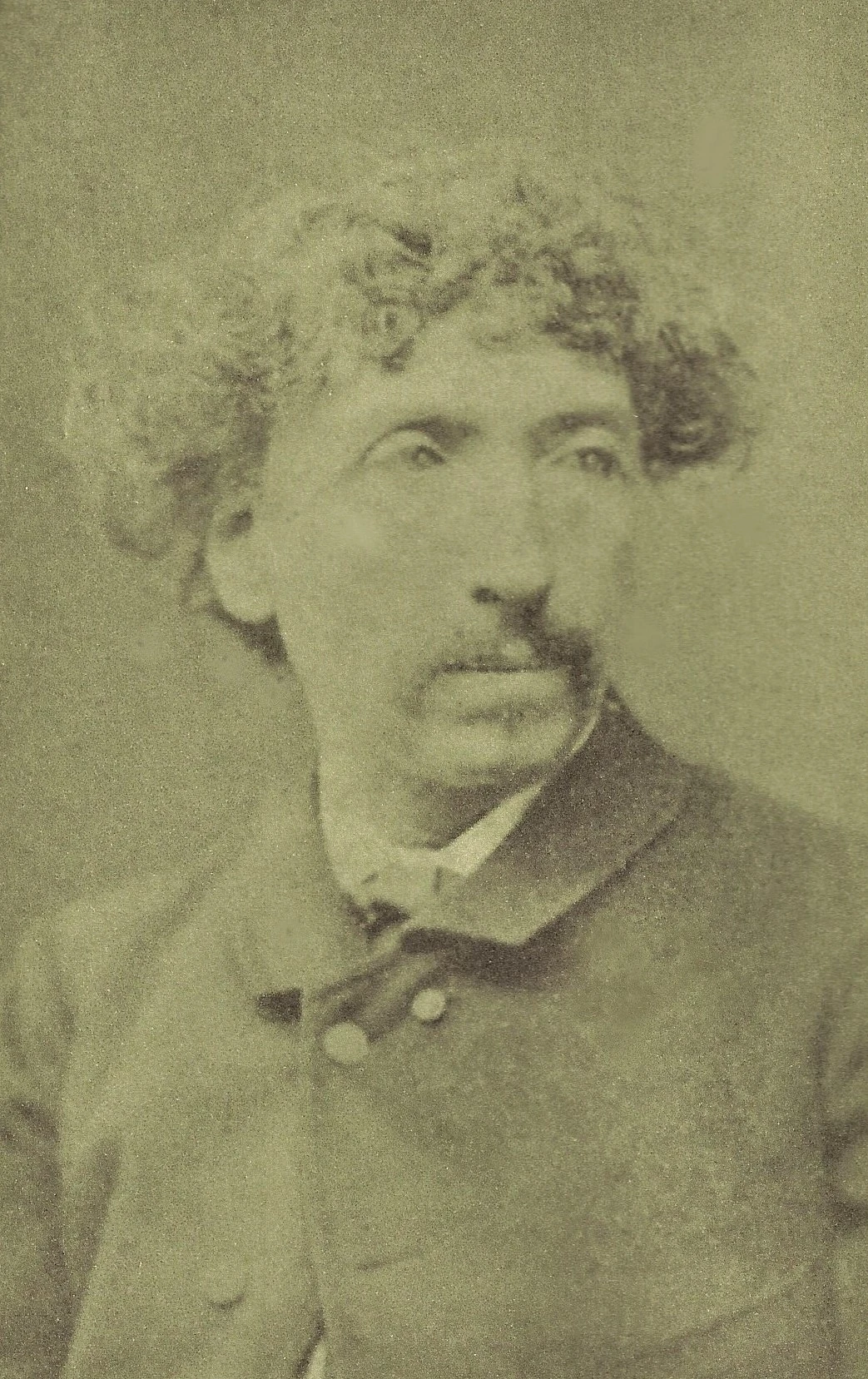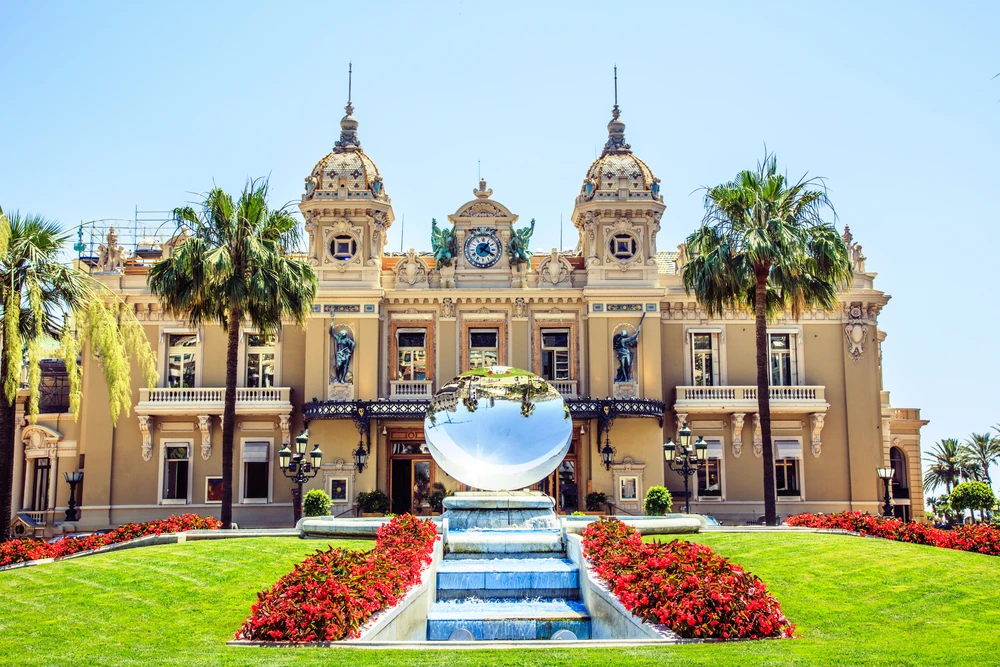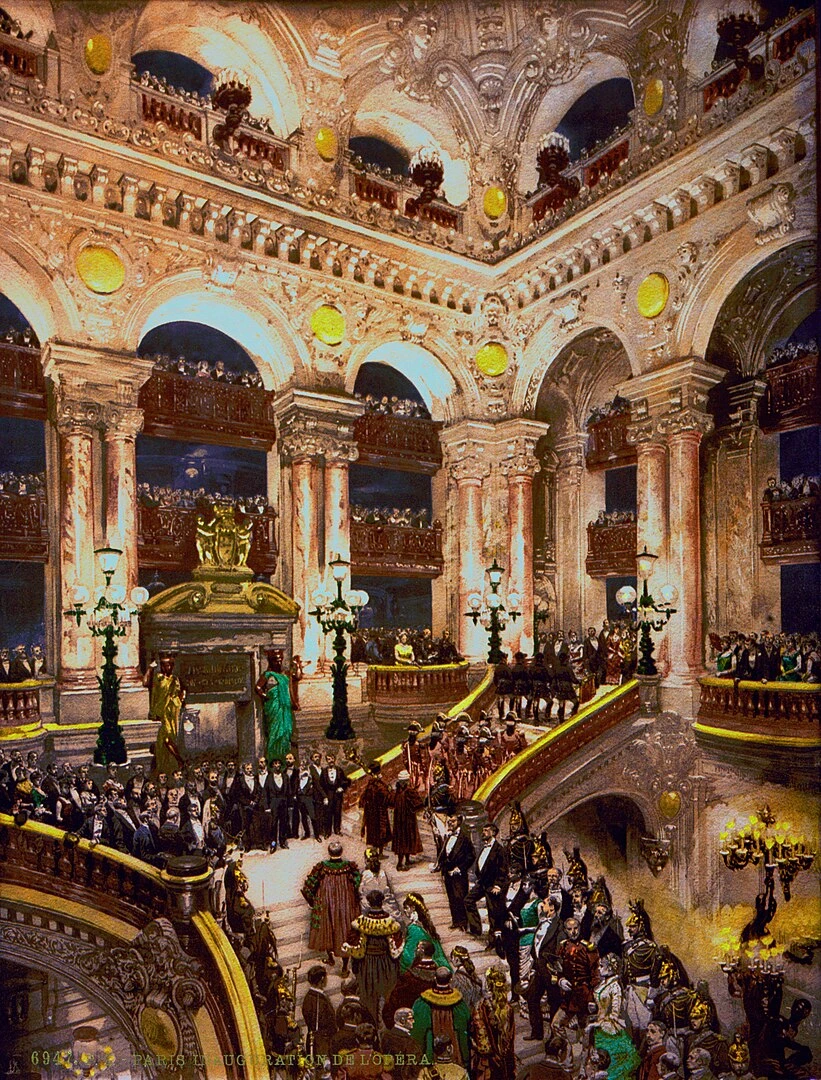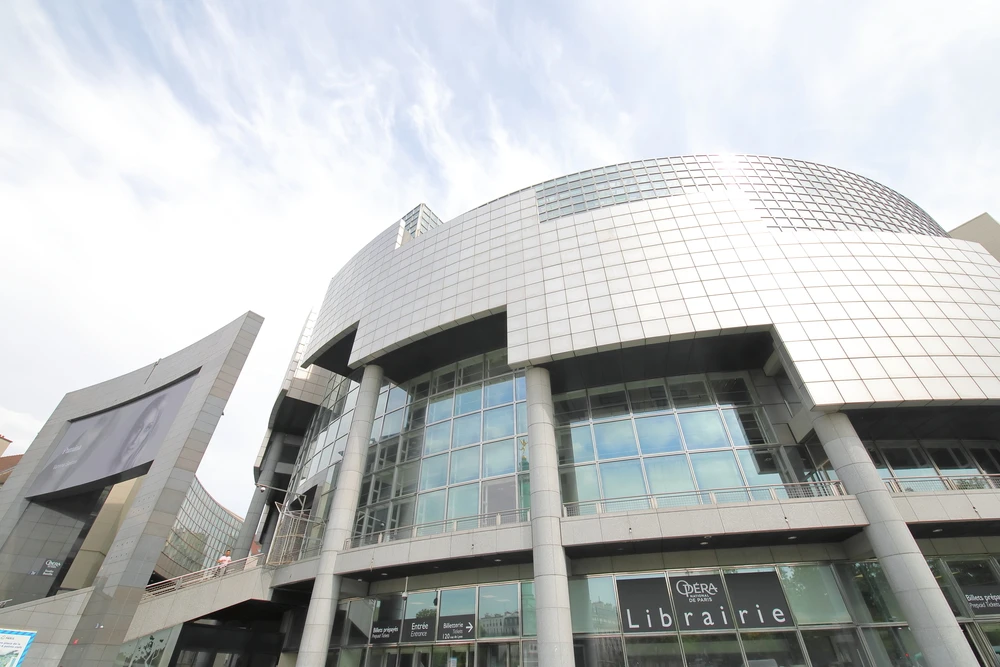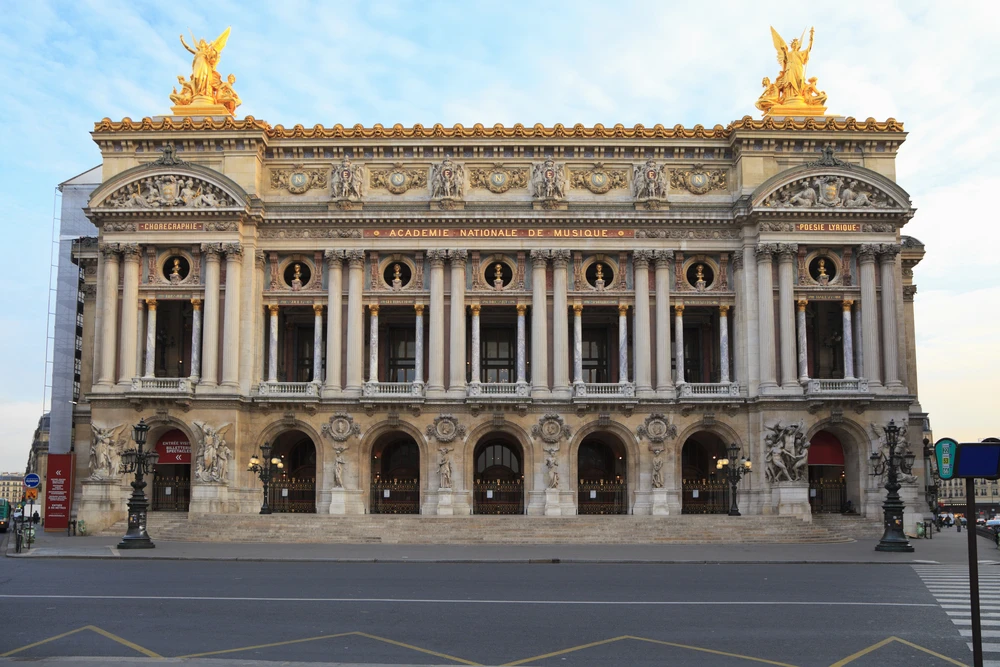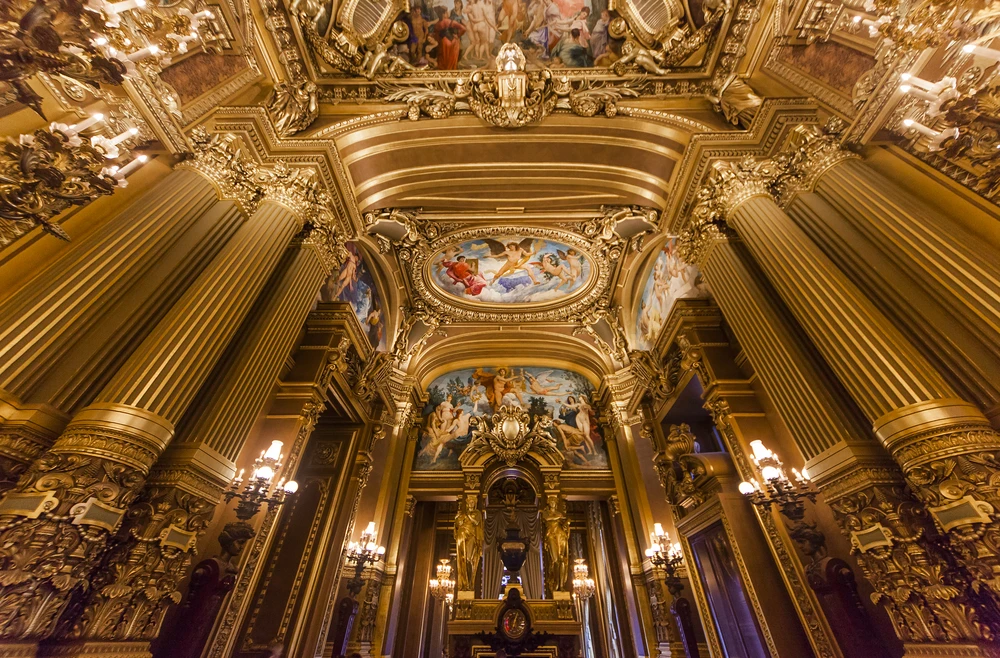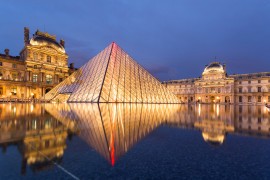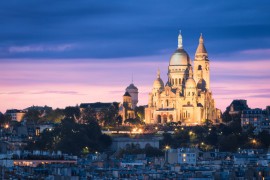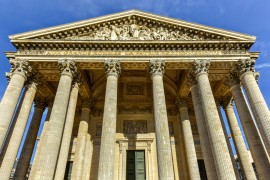What to see at the Opéra Garnier
The square around the Opéra is magnificent, as is the avenue that bears its name. Don't miss the "belt of light", made up of sixty candelabras (originally gas-lit until 1954). Some of the lampposts are caryatids that hold the light. There are also rostral columns reminiscent of Paris and its motto "flotte mais ne coule pas" ("float but don't sink ").
The façade on the Avenue de l'Opéra side
Atop the copper-covered dome, Apollo is accompanied by Music and Poetry (by sculptor Aimée MILLET). Below, two gilded groups (the interior is in stainless steel). These are two statues by Charles GUMERY. Measuring 7.50 meters high, they represent harmony on the left and poetry on the right.
One of the two gilded groups on the façade of the opera house. Here, l'Harmonie by Charles GUMERY. Photo chosen by monsieurdefrance.com: Baloncici via depositphotos.
Finally, on the first floor, there are 4 groups of stone statues, sculpted by various artists. From left to right: Poésie (by François JOUFFROY), musique instrumentale(by Eugène GUILLAUME), the most sulphurous is danse, whose naked body provoked indignant reactions and caused the statue to be damaged several times (one man threw black ink on it, for example), and a press campaign even called for its removal, despite a petition from the ballet dancers. Finally, the last statue on the right is the drame lyrique (by Jean-Joseph PERRAUD).
The dance, whose badly damaged original was replaced by the current statue in the 20th century. Photo chosen by monsieurdefrance.com: PhilipMinnis via depositphotos.
The Pythian Basin / Le bassin de la Pythie
Pythia by MARCELLO. Photo chosen by monsieurdefrance.com: Laura-Zago.0293 via depositphotos
The Pythia was the one who, seated on a tripod, announced the future in the name of Apollo at the sanctuary of Delphi. Appolon is the Greek god of the arts, so in the Opera she is considered the god's temple. A special effect once made it possible to distinguish her in a kind of mist (the Pythia breathed vapors from the earth before announcing her prophecies). This is one of the few Parisian statues by a woman: Adèle d'AFRY (1836-1879), Duchess of CASTIGLIONE-COLONNA, under the pseudonym MARCELLO.
The grand staircase / Le grand escalier
We then discover the two absolutely spectacular flights of steps of the grand staircase. A true architectural feat, the ceiling reaches a height of 30 metres. All gilded and colored marble, the staircase, which leads to the different floors and the foyez, is illuminated by two female groups holding torches.
The grand staircase of the Opéra Garnier. Photo chosen by monsieurdefrance.com: Isogood via depositphotos
We then discover the two absolutely spectacular flights of steps of the grand staircase. A true architectural feat, the ceiling reaches a height of 30 metres. All gilded and colored marble, the staircase, which leads to the different floors and the foyez, is illuminated by two female groups holding torches.
The Glacier rotunda / Le glacier de la Rotonde
The ceiling of the glacier room. Photo chosen by monsieurdefrance via depositphotos.
The Rotonde du Glacier is well worth a visit. This room was designed for the refreshment of VIPs in the dressing rooms (they could order in advance using an ingenious bell system), and boasts a superb ceiling painted with a round of bacchanalia and fauns by Alexis-Joseph MAZEROLLE (1826-1889). The eight tapestries on the sides also depict the various drinks served here in 1880, including champagne, tea, coffee and even... Orangeade.
Le Grand foyer
The grand Foyer. Photo selected by monsieurdefrance.com via depositphotos.
Preceded by two salons, one dedicated to the Moon on one side, the other to the Sun, the Grand foyer is truly spectacular, with a world that plunges you into the French Renaissance châteaux and reminds you of the Hall of Mirrors at Versailles, with its 6-metre-high mirrors facing the windows. It has 5 bays and is adorned with 20 statues illustrating the qualities required of artists. The ceiling, painted by Paul BAUDRY (1826-1886), tells the story of music, tragedy and comedy. For a long time, the place was reserved for men, with the rare exception of a visit by the Queen of Spain. Fortunately, it is now open to both men and women.
The ceiling of the grand foyer, painted by Paul BAUDRY. Photo chosen by monsieurdefrance.com: depositphotos.
The showroom
It's enormous, and truly the heart of the Opéra Garnier. Inspired by Italian-style theaters, it's over 30 meters wide, 32 meters deep and 20 meters high, and seats 1,900 on 5 levels.
The grand hall of the Opéra Garnier. Photo chosen by monsieurdefrance.com: dépositphotos.com
Ceiling and chandelier
The ceiling of the cupola, which measures over 50 m2, was originally painted by Jules-Eugène LENEPVEU (1819-1898), Napoleon III's favorite painter. It depicts the muses. It was covered (but not destroyed) in 1964 by the work of Marc CHAGALL (1887-1985), which was marouflaged over Lenepveu's work. The ceiling is divided into 5 sections, each recounting one of the great works of opera and dance, and paying tribute to 14 composers and their works, including Glück, Mozart, Bizet...
Chagall's ceiling. Photo selected by monsieurdefrance.com; Izogood via depositphotos.com
A huge chandelier is located in the center of the ceiling. It is original. A persistent legend has it that it fell on the audience. This is not the case, but it is true that a few elements fell during a performance in 1896. A panic resulted in injuries. This chandelier is magical: made of gilded bronze, it has been installed since 1874. At the time, 340 gas spouts were used to light it. It has been fully electrified since 1957.
The chandelier at the Opéra Garnier. Photo chosen by monsieurdefrance.com: Jybiard via depositphotos.com
Key figures:
The Garnier opera house: over 200 curtain raisings a year, more than 1 million visitors. It's a surface area of over 15,000 M2 on the ground, and a depth of over 73 meters from the lightning conductor to the tanks, which are several dozen meters below ground.
Why little rats? "les petits rats de l'opéra"
Photo chosen by monsieurdefrance.com: billiondigital via depositphotos.
Don't forget that the Opéra Garnier is a music and dance academy. It is here that classical dance is taught (ballet is very old in France, and has served as an example throughout the world). The tradition is to nickname young students "petits rats". The origin of the expression is obscure, but it is thought to derive from the sound of their ballet shoes on the floor. Furtive, repeated noises reminiscent of running rats, especially since rehearsals were held in the attic. The noise came from above.
The Paris opera near 4 centuries of history
Mademoiselle Camargo, print by Laurent Cars, after Nicolas Lancret, 1731. Image selected by Monsieurdefrance.com via Gallica.fr
1645: the first opera performed in France
It was Jules MAZARIN (1602-1661), of Italian origin, who introduced opera to Paris and France in 1645 by installing an Italian troupe in the "Petit Bourbon ", a private mansion opposite the Louvre. It has to be said that it can accommodate a lot of people, as it proved during the Estates-General of 1614, one of the rare moments when the monarchy consulted the three orders that made up France at the time: the nobility, the clergy and the Third Estate (all the others, in fact). The young Louis XIV, who lived in the Louvre and had a passion for dance, attended the first opera to be performed in France: "La Finta Pazza" by Francisco SACRATI (1605-1650) on December 14, 1645. The hall was demolished some 15 years later to make way for what is now the Louvre's colonnade. In 1662, the "Salle des machines" was inaugurated not far from the Louvre, in the Tuileries gardens. With a capacity of 4,000, it was destroyed by fire in 1871. It had been an auditorium but, less well known, the seat of the National Convention in the midst of the French Revolution. Nothing remains of it today. The Opéra, meanwhile, has moved on...
The Salle du Petit Bourbon was a vast space. It hosted the 1614 Estates General and the first French opera in 1645. Image chosen by monsieurdefrance.com: Wikipedia.
In 1661, a new opera house, part of Louis XIV's newly-created "Académie royale de Musique", was set up in the Salle du jeu de paume (a sports hall, paume being the ancestor of tennis). Located in the Latin Quarter, this hall hosted the first French opera in history: "Pomone" by Robert CAMBERT. The hall was used not only for opera, but also for Molière's plays. Many ballets were performed here, including those by BEAUCHAMP, a choreographer who drew inspiration for his dances from the pigeons he fed in his attic. The Salle du Jeau de Paume was the birthplace of the Comédie Française, which closed in 1673. It must be said that the location of the opera had changed. Operas were now performed at the Palais Royal.
Libretto for Pomone by Robert CAMBERT, the first French opera in history. Image chosen by monsieurdefrance.com: Wikicommons.
The Royal Palace
Built by Cardinal de RICHELIEU (1585-1642), the Cardinal's palace became the Palais Royal when he bequeathed it to King Louis XIV on his death. It was finally Philippe d'ORLEANS (1640-1701), known as "Monsieur", who took possession of the premises, which included the auditorium built in 1641 for the Cardinal and occupied by Molière and his troupe for just over 10 years (1662-1673). It was then used by Jean Baptiste LULLY (1632-1687), who reclaimed it and made a number of changes to its layout. In what came to be known as "l'opéra", not only were shows staged, but also, from 1713 onwards, masked balls, which established the venue's reputation as a festive (and somewhat lustful) place. Numerous celebrities took part in these balls, thanks to the masks that made them anonymous. Louis XV in his youth, Casanova and many others. It burned down on April 6, 1763 (2 people were killed in the blaze) and the building, badly damaged, had to be rebuilt.
The interior of the Palais Royal's first opera house in 1761 during a performance of a play by Lully. Source de monsieurdefrance.com : Wikicommons.
On January 26, 1770, "Zoroastre", the opera by Jean Philippe RAMEAU (1683-1764), was performed in a brand-new auditorium designed by the architect Pierre Louis MOREAU-DESPROUX (1727-1794), who created one of the first semi-circular auditoriums in history . It has 4 rows of boxes and seats 2,500 people. Since the previous opera house had burned down, MOREAU-DESPROUX equipped the new one with a reservoir system that was more efficient at extinguishing fires. In addition to the auditorium, the architect transformed the facades of the Palais Royal, giving it the look it still has today. The Opéra de la rue de Valois continues the traditions of its predecessor. Costumed balls (attended by Queen Marie-Antoinette) and numerous shows were held here. The first years of its opening were marked by the quarrel between fans of PICCINNI (1728-1800) known as "piccinistes" and fans of GLUCK (1714-1787) known as "gluckistes" (including Marie Antoinette, who intervened in favor of Glück).
The curtain and Figaro
Pierre Augustin de BEAUMARCHAIS by Jean-Marc Nattier (18th century). Image chosen by monsieurdefrance.com: Public domain, via Wikimedia Commons
It was at this time that Glûck proposed a novelty: closing the curtains when changing scenery , which was usually done in full view of the audience. The young Mozart amazed everyone in the summer of 1778 with "Les petits riens", for which he had composed the music (1756-1791). It was also here, in 1784, that BEAUMARCHAIS (1732-1799) premiered his "Marriage of Figaro". A play that heralded the French Revolution, as we hear "qu'avez vous fait pour tant de biens" and the famous "vous ne se sont donné que la peine de naître" hurled at a nobleman at a time when everything depended on birth, especially privileges. On June 8, 1781, another fire ravaged the Palais Royal opera house, killing 12 people. All the sets were lost. Until a new opera house could be rebuilt, performances were held at the Hôtel des Menu-Plaisirs (the king's furniture repository), before being moved to a new location.
Actresses, dancers and courtesans.
"La Clairon", (Claire Léris), great actress (and courtesan) of the XVIIIE century represented by the painter Van LOO as Medea (XVIIIth century). Image chosen by monsieurdefrance.com: Public domain Wikimedia Commons.
Numerous actresses and dancers have worked in opera over the centuries. In the 17th century, comediennes were extremely famous. They often combined two activities, one artistic and the other as courtesans. Maintained by powerful nobles (or bourgeois), they lived in style. The 19th century continued this "habit" with dancers. Hence the expression "avoir sa danseuse" ("to have one's own dancer" ), referring to a pleasure that costs you money but brings you pleasure.
And the corks
Up until 1780, protocol dictated the location of the carriages used to transport the public. This meant that princes and ministers could park first, and the bourgeoisie last. It is also the princes or ministers who can move their vehicles first. The others have to wait until they're ready and ready to leave the room before they can move their vehicles, which (already) is causing inextricable traffic jams in the neighborhood.
The Saint Martin gate / Le théâtre de la porte Saint Martin
The Porte Saint Martin theater in 1791. Image chosen by monsieurdefrance.com: By Jean-Baptiste Lallemand - Bibliothèque nationale de France, Domaine public / Gallica.fr
Following the fire of 1781, Nicolas LENOIR (1733-1810), architect to Queen Marie Antoinette, promised to build a new opera house in less than three months. He kept his word (the workers worked day and night) and built the Théâtre de la Porte Saint Martin, located at 18 boulevard Saint Martin in Paris. 1800 seats, 4 rows of boxes and a premiere on October 27, 1781 with PICCINNI's "Adèle de Ponthieu". Tibulle et Délie" was performed in 1784, the first opera composed by a woman: Mademoiselle de BEAUMESNIL (1748-1802). Shortly before the storming of the Bastille, the theater was taken over by the mob, who looted the sabers from the props (the cardboard axes and clubs were wisely left behind, if a letter from the director of the time is to be believed). It is said that these swords were used for the storming of the Bastille on July 14, 1789. In 1791, for the first time, the names of the singers and dancers in the shows were posted. After giving a few "patriotic" shows, the venue was closed in 1794. It has to be said that the directors, FRANCOEUR and CELLERIER, were not known for being staunch revolutionaries. One of them even spent a year in prison. It becomes a storage facility. It reopened as a theater in 1802. It is still a venue today (along with the Petit Saint Martin theater, which specializes in comedians).
A theater: 2 attacks.
The Rue Saint Nicaise attack targets Napoleon on his way to the Opéra, at the request of his wife Josephine, who wants to distract herself. Period engraving.
Opposite the Bibliothèque Nationale, Mademoiselle Montansier's theater took over from the Porte Saint Martin theater and became the "théâtre national" (or theater of the arts). The first show was staged here in 1794. The auditorium was enormous, seating 2,800 spectators and boasting a beautiful pit that could accommodate over 50 musicians. The masked balls resumed in 1807, with the approval of Napoleon 1st, who bore no grudge when he was the victim of an assassination attempt on December 24, 1800, on his way to the opera. He miraculously escaped unharmed, although 22 people were killed and 46 houses in the Rue Saint Nicaises were destroyed. The assassination of the Duc de Berry (1778-1820) was, alas, a success. King Louis XVIII's heir was stabbed to death as he left the theater in 1820. This tragedy led to the closure of the opera house on rue de Richelieu, which was razed to the ground by order of the king. A square was laid out in its place. Absolutely nothing remains of the theater.
The death of the Duc de Berry by Cibot. Source de monsieurdefrance.com : wikimedia commons / public domain.
The Opera Le Peletier
The grand auditorium of the Le Peletier opera house in 1864. Designed as a temporary structure, it was an exact replica of the opera house on rue de Richelieu. It lasted over 50 years.
Following the destruction of the rue Richelieu opera house after the death of the Duc de Berry, a new provisional opera house was built: the Opéra Le Peletier , because it was located on this street near the Boulevard des Italiens (a provisional opera house that was to last more than 50 years). Based on plans by architect François DEBRET (1777-1850), a new auditorium was built in just 1 year, using elements from the opera house on rue de Richelieu. It could seat 1,800 spectators, and was equipped with innovations such as gas lighting for special effects. It is famous for its sound quality, probably due to its temporary, and therefore lightweight, structure. It did have one drawback, however: it was located in the middle of the narrow streets of old Paris, which exposed Emperor Napoleon III to attacks. He would prefer an Opera House with unobstructed access. And just as well, Baron Haussmann's renovations were reshaping Paris. The Le Peletier opera house was destroyed by fire on the night of October 28-29, 1873. Its destruction accelerated work on a new opera house: the Palais Garnier.
Birth of the Garnier opera house
Emperor Napoleon III by Hippolyte FLANDRIN.
In 1858, when Napoleon III was assassinated on his way to the Le Peletier opera house, he decided to build a new opera house in an open area that would avoid the inextricable network of Parisian streets. A competition for an "Imperial Academy of Music and Dance" was launched in 1860. Several candidates responded. The one selected was Charles Garnier. He was unanimously chosen by the jury (presided over by the only bastard son of Napoleon I: Charles Léon Walewski). It has to be said that his project was ambitious , perhaps too much so for some who, faced with the gilding imagined, reproached: "too much gold! Too much gold! It would take a long time to complete, since work began in 1861 (even though the foundation stone was laid in 1862) and lasted over 10 years, interrupted by budgetary problems and the war of 1870. The Paris Opera was inaugurated on January 5, 1875 .
Charles GARNIER and his close collaborators. Photo chosen by Monsieurdefrance.com: Gallica.fr
At the same time as Haussmann's works
It's hard to imagine the immense work that went into giving Paris its current appearance over a period of almost 40 years. From 1858 onwards, at the behest of Napoleon III, the Prefect of Paris, Baron Haussmann, launched a colossal project to radically redesign Paris , which at the time was still very much a medieval city, with its narrow streets and half-timbered houses. Entire districts were demolished to create vast avenues and gardens... The only district left largely untouched was the Marais, where the opera house was built at the top of an avenue dedicated to it. The triangular shape of the land made it difficult to exploit.
"Too much gold" judged the detractors of Charles GARNIER's project... Photo chosen by monsieurdefrance.com: Gilmanshin via dépositphotos.com
Charles GARNIER
Charles GARNIER image chosen by Monsieurdefrance.com: Truchelut Institut de France photographer.
Charles GARNIER was born in Paris on November 6, 1825, to a Sarthe family. After studying at the Beaux-arts, he was a boarder at the Villa Medicis in Rome. His travels took him to Italy, Greece and Istanbul. The Orient left a deep impression on him, particularly in terms of color. And this passion for color is one of his trademarks. He unanimously won the 1861 competition to design the new Paris opera house. He was also responsible for numerous buildings in Italy, Vittel (where he designed part of the Vosges spa) and Monaco, where he designed the Monte-Carlo casino.
Monaco's Casino de Montecarlo is the brainchild of Charles GARNIER. Photo chosen by monsieurdefrance.com: Garsya via depositphotos.
The inauguration
After 15 years of construction, the Opéra was inaugurated on January 5, 1875. Not only was Charles GARNIER not honored, he was not even officially invited. He was obliged to buy his seat (2nd class). The opera's famous costume balls immediately resumed. A tradition begun in 1715, it lasted until 1903, when it went out of fashion. The Republic did not hesitate to make use of this monument designed by the Empire, and President Félix FAURE welcomed Tsar Nicolas II of Russia and his wife for a performance there in 1896.
The inauguration of the opera house. Period painting.
The Bastille opera house
It was the last opera house to be built in Paris. The Opéra Bastille was inaugurated in 1989 on the site of the famous Bastille (destroyed after its capture in 1789) to celebrate the bicentenary of the French Revolution. Built on the site of the former Paris Bastille train station, the auditorium seats 2,745. The pit can accommodate 150 musicians. Like the Garnier opera house, the architect, Carlos OTT, was chosen through a competition. The grand opening took place on July 13, 1989, in the presence of French President François MITTERRAND and 30 heads of state, including Bush Sr. and Margaret TATCHER.
The façade of the Opéra-Bastille. Photo chosen by monsieurdefrance.com: TKKurikawa via depositphotos
How do I get to the Opéra Garnier?
The facade from Place de l'Opéra / Photo chosen by monsieurdefrance.com: Abadesign via Depositphotos.
Address
Place de l'Opéra, 75 009 PARIS or 8 rue Scribe, 75 009 PARIS. Enter via rue Scribe.
Metro
Opéra station (lines 3, 7 and 8), Chaussée d'Antin station (lines 7 and 9), Madeleine station (lines 8 and 14)
R.E.R
Line A AUBER station
Bus
Lines 20 / 21 / 27 / 32 / 45 / 52 / 66 / 68
Parking
Q PARK Bruno Coquatrix: Rue Bruno Coquatrix, 75 009 PARIS
Parking Meyerbeer Opéra: 3 rue de la Chaussée d'Antin, 75 009 PARIS
Parking Haussmann Lafayette: 48 boulevard Haussmann, 75 009 PARIS
Official website
Times and prices Paris Opera
The interior of the Opéra Garnier. Photo chosen by monsieurdefrance.com: depositphotos.com
Opening hours
The Palais Garnier / Opéra de Paris is open daily from 10am to 5pm (last admission 45 minutes before closing time).
N.B .: First and foremost, it's a performance venue, and therefore a place for artists to work. The hall is frequently closed for performances and rehearsals. Luggage is not allowed , and Monsieur de France gives you an overview. For up-to-date schedules and reservations, always visit the official website .
Rates
2023 prices: 15 euros for individuals. 10 euros for concessions.
Access is possible for people with reduced mobility.
Monsieur de France gives you an overview. For up-to-date rates and reservations, always visit the official website .
Official program
On the Opéra Garnier's official website, you'll find all the shows on offer during the current season.

